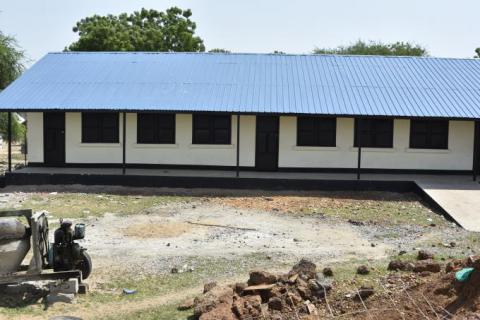Rising Above the Floods: Transforming Education in South Sudan with Flood-Resistant Classrooms
Save the Children and other implementing partners with funding from Global Partnership for Education (GPE) in partnership with the Ministry of General Education and Instruction have constructed and rehabilitated 22 primary and secondary schools in Jonglei, Warrap, Northern Bahr El Ghazal, Unity, Warrap, Lakes, Upper Niles States and Greater Pibor Admirative Area of South Sudan.
Photos of old and new constructed classroom blocks in Bor A and Bor B primary school, Jonglei state funded by GPE. Credit: Estella John, Save the Children.
JUBA - The Global Partnership for Education (GPE)-funded Flood Response under the Multi-Year Resilience Programme for South Sudan, implemented by Save the Children and partners, is supporting schools in flood-affected areas by constructing flood-resilient classrooms, strengthening resilience among school communities through early warning systems, preparedness, and response planning. This initiative ensures that children do not miss classes during the flood season. As a result of the GPE flood response project, there has been an increase in the number learners joining schools in the Lakes and Jonglei states of South Sudan.
In Bor and Rumbek, teachers have reported a higher enrollment of students following the completion of new flood-resistant classroom blocks. Notable schools that have been constructed include Bor A and Bor B primary and secondary schools, Ager Gum primary school, Tiap Tiap primary school, Tonj Girls primary school, Mayom primary school, and Marial Kuel primary school.
“Previously, educational opportunities were scarce for children in this remote community. Now, over 600 students are enrolled in Mariel Kuel, eager to learn and grow," said Sanrino Wol, head teacher, Mariel Kuel primary school.
The Multi-Year Resilience Programme for South Sudan is a holistic programme that address’ gender and inclusion, disaster risk management, mental health and psychosocial support, the provision of scholastic materials to schools, and teacher training. With collaboration with the Ministry of General Education and Instruction, the programme works to achieve quality education for all children.
According to Mr. Jeremiah Gor, the head teacher of Mayom primary school, “The construction of flood-resilient classrooms project has had a broader impact beyond an increase in the number of new students. it has also improved the school’s sanitation, with the installation of rainwater harvesting facilities and the completion of two latrines for boys and girls equipped with handwashing facilities. This has resulted in a clean and healthy learning environment."
GPE newly constructed wash facility at Bor A primary school, credit: Estella John / Save the Children
Tiap Tiap Primary School is the only primary school in the hard-to-reach remote region of Cueibet County in Rumbek, Warrap State. The Cuibet community joined forces to build a temporary school structure to support children’s education. However, the school had low enrollment because of the inadequate and unstable structure. In 2023, a new flood-resistant classroom block was built to replace the temporary structure, which was frequently damaged during floods.
“Since GPE's support began, enrollment has skyrocketed from 215 to 558 students, with a remarkable 180 of them being girls," said Salva Mawut, the head teacher of Tiap Tiap Primary School.
In South Sudan, flooding has caused many children to drop out of school as their schools were submerged in water. Families have been forced to relocate to higher lands to rebuild their lives. The South Sudan Education Cluster reported that 895 schools (partially or completely) were destroyed by floods in 2022, directly impacting 215,000 children.
Save the Children and other implementing partners with funding from GPE are working in partnership with the Ministry of General Education and Instruction to provide quality education and a safe learning environment for the children of South Sudan. The Ministry ensures that all school constructions follow the agreed-upon standard flood-proof design, are accessible to all children, and have sufficient ventilation to protect them from heatwaves.
 South Sudan
South Sudan 

